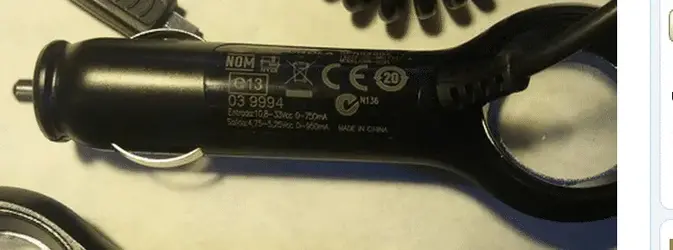I will disagree with Foxcat on this one. I do not think there is much risk going slightly above the amperage of the OEM power adapter. Higher voltage is definitely no bueno.
-Lonnie
No need to disagree, going above the amperage rated for the OEM power adapter will not significantly harm the battery, but it will (*as mentioned by drew96dawg) decrease the lifespan of the battery - which is the SOLE reason why I suggest NOT going with a higher current than the OEM power adapter.
As long as you don't go over 1 amp it shouldn't cause significant harm but any increase in current will decrease the amount of charge cycles a battery will last
Sent from my DROID2 using Xparent Blue Tapatalk 2
Exactly. The faster you charge, the more you stress the battery and the less charge cycles you will get out of it over time. Given that these batteries are already (in most cases) marginally large enough to give one day's moderate use, and considering that the expected lifespan of these batteries is 300 - 500 charge cycles (using the OEM charger), any reduction in cycles will negatively impact the user experience. In other words, the battery will have trouble lasting a full day as you near its 1 year birthday. For phones with removable batteries that may not be such a big deal, but for those which are not "user replaceable", this can spell disaster either as your phone can't last even to the evening on a charge, or as an expensive replacement process.
500 cycles at one charge per day (10% to 100%), results in 555 charges of 90% each for a total of 50,000% of rated capacity before the battery is at what is called "end of life" (holds less than 80% of original rated capacity). At that rate, you'll get just about 1.5 years out of the battery (555.55-365 (one year) /30=6.35 or one year, 6.35 months.) If you charge faster, you will be leaning toward that 300 number and away from the 500 number. 300 cycles at 90% results in 333 charges, or not quite a year.
Now, the phones will already have a current limiter in them so even if you plug it into a 2 Amp charger adapter, it will only allow the battery to "see" the current level it has been pre-determined as a safe maximum. I believe that would most often be close to or just under 1 Amp. Motorola for instance, has their wall adapters at 750mAh. For the Droid RAZR with a 1,780 mAh battery, that's a charge rate of just over .4C, so it's set up to preserve lifespan of the battery. The Droid RAZR MAXX with a 3,300 mAh battery uses the same wall adapter, so in that case the battery is being charged at a rate of just over .22C, or less than one quarter of capacity. This was OBVIOUSLY intended to extend the lifespan of the battery. I also have a Motorola "Rapid Charger" adapter (
http://www.amazon.com/Motorola-Vehicle-Adapter-micro-USB-Charger/dp/B000S5Q9CA), for my car and I just checked it online...guess what? Its output is 960 mAh, just under 1 Amp (see images below).


One other note, these batteries actually perform better (i.e. last longer) if NOT charged fully each time, and if NOT drained before charging, but instead to charge FREQUENTLY, even if only a quick 20% or 30% boost. If you plug in whenever it's relatively convenient, you can actually increase the charge cycles dramatically - in some cases upwards of 1,500 complete charge cycles , can be attained by this method. The "sweet spot" is indicated at discharges not below about 30% and charges not above about 75% to achieve the longest serviceable lifespan. A complete charge cycle is represented as the cumulative of one or more partial charges and discharges which when added up total 100% charge and 100% discharge. For instance, a 100% charged battery that is used for 60%, then charged back to 100%, then used for 40% and charged back to 100% has just completed one charge cycle of 100% (60% + 40% = 100%). Likewise, a battery that starts at 100% and is used for 70%, then charged to 50%, used to 20%, and then charged to 100% also has completed one 100% cycle (discharged 70% + 30% = 100%, and charged 20% + 80% = 100%).
I think 1 amp is a lot for a cell phone battery to draw. If the phone/battery draws that much, there is likely something not right with something other than the power source. Of course, a more robust power source could make the outcome uglier.
-Lonnie
1 Amp may be a lot for a cell phone to "allow" a battery to draw under normal circumstances, but the battery can draw MUCH more than 1 Amp. RC Car enthusiasts know all too well that you can charge a LI or LIPO battery (the kind in most cell phones now), at upwards of 6C (which represents 6 times the rated capacity), but also that it's quite common to charge at 1C (the rated capacity). If the battery is 1,800 mAh, and you charge at 1C, you will be supplying the battery 1.8 Amps. It's recommended to get the most life out of these batteries, to charge at .5C or less. In that case, an 1,800 mAh battery charged at .5C would draw 900 mAh. Most wall adapters designed for these phones are going to be putting out in the area of 750 mAh to 850 mAh.
So again to reiterate...I recommend staying with the OEM adapter unless you don't mind having your battery begin to show signs of aging (not holding near a full capacity charge), in a year or less.



